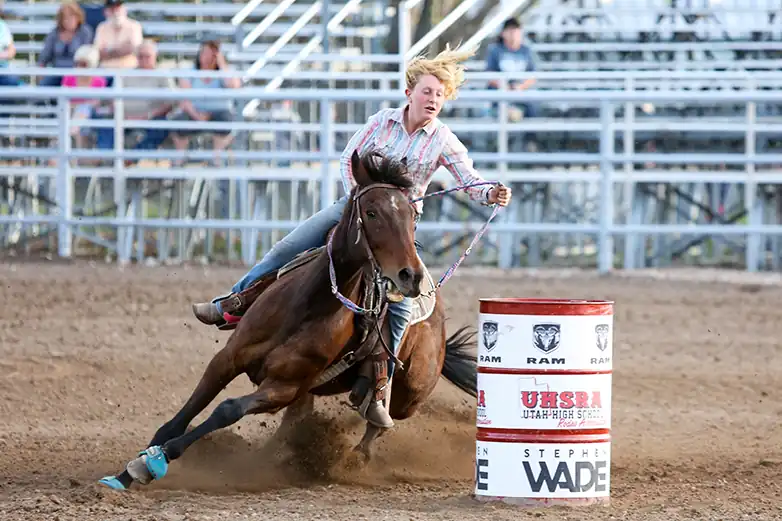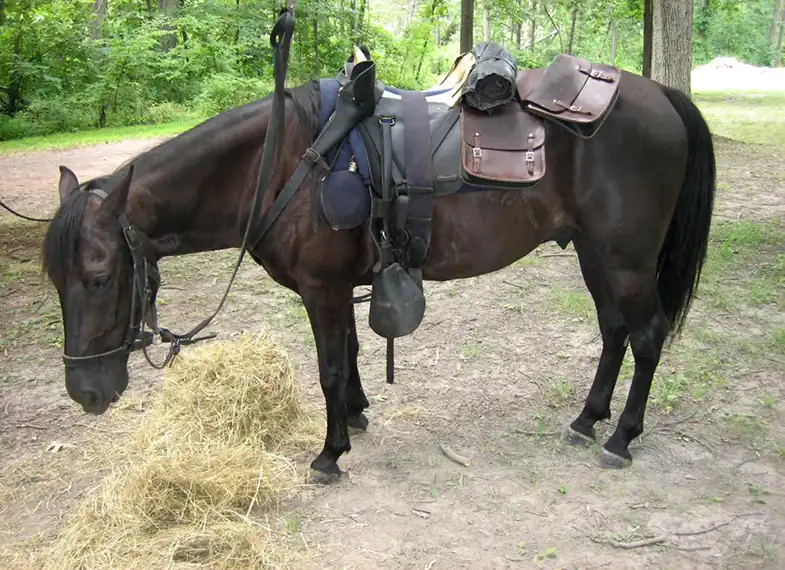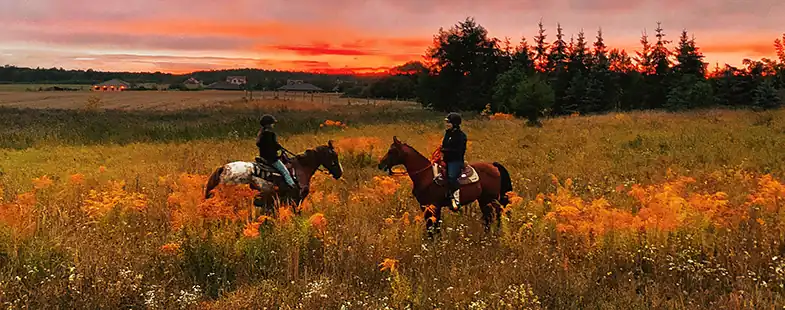Right from day one of horse management school, we’re told you should never feed a horse before riding but is this really always the best thing for your horse? Some rules just shouldn’t be questioned but with so many people saying it’s actually better to feed your horse before riding I thought I’d look into the science behind this rule.
Should you feed a horse before riding? While it’s okay to give your horse hay before riding you should always avoid feeding them any grain at least an hour before riding, or at least three hours if you’re planning on going for a long or strenuous ride.
The rule of not feeding horses before exercise came about at a time when horses ate large cereal-based meals that would lay heavily in their stomachs. Since then feeds have become more fiber-based which makes it easier for them to digest but does this mean that you should still avoid feeding your horse before riding them?
How long before riding should you feed a horse?
Most horses don’t need a grain-heavy diet but if your horse does have grains (such as oats or barley) then you should give him enough time to digest this properly first before riding.
There are a couple of reasons for this, the main one being the fact that when horses are exercising the blood flow is diverted to the muscles. This means that the digestive organs don’t have enough blood so the natural movement of the gut slows down. The slower movement means that the food is sitting in their stomach for longer and therefore increases their risk of colic.
The other reason is that if your horse has a full stomach his lungs won’t have the space to work properly, they’ll have less room to move and will therefore have to work much harder. This will have a negative impact on your horse’s performance as well as his ability to recover afterward.
All horses are different but as a general rule allowing your horse an hour to digest his food is enough, that said though if you’re planning on going for a long trail ride or doing something strenuous you should give him at least three hours before riding.
Can you ride a horse on an empty stomach?
Horses are constantly producing stomach acids which is why they need to spend a lot of time (up to 14 hours a day) grazing. This continual grazing produces a lot of saliva which helps to protect the delicate lining of the stomach but it also means that there’s often something in the horse’s stomach for the acid to attack.
Having an empty stomach means that there’s nothing to protect the stomach lining from the acid but it also means there’s a lot of excess acid squooshing around. Normally this stays in the lower part of the stomach but while exercising it can, if there’s too much, splash around and irritate the more delicate upper part of the stomach, putting the horse at serious risk of gastric ulcers.
The best thing to do is to make sure your horse has a small amount of forage in his stomach prior to riding. This will reduce the risk of the gastric acids irritating the stomach lining because instead of splashing around it’ll be working to break down the hay.
As an added bonus, feeding your horse some hay before riding means he’ll be more alert and focused on you rather than thinking about how hungry he is and when he’ll get his next meal.
Can you feed a horse hay before riding?
Hay is easy for horses to digest so feeding them a small amount before exercise won’t cause any issue but will instead prevent the stomach acids from moving around because they’ll be busy ‘attacking’ the hay. The process of eating will also help to produce saliva which acts as a natural barrier, reducing the harmful effects of the acids on the stomach wall.
You can, and should, feed your horse a small amount of hay before riding them
The real question really should be how much hay should you feed your horse before riding them. Typically, before riding, you should give your horse between 200g and 400g of hay for every 100Kg of their total body weight. The actual amount you give will depend on when they were last fed and how much they had to eat. For example, if your horse was grazing just before you ride then you only need to give him a handful or so of hay, just enough so that he has something in his stomach. If, however, he was grazing between 30 minutes and two hours ago you should give him around 200g of hay per 100Kg of body weight, whereas if it was more than two hours ago then you should give him roughly 400g per 100Kg.
Can you feed a horse after riding?
While a lot of focus is placed on feeding your horse before riding not much is talked about feeding them after riding but this is just as important. If your horse is worn out through exercise then he’s not going to be able to digest his food properly which can lead to all manner of issues, not least colic.
As a rule, you should wait around an hour before feeding your horse after exercise
Once you’ve finished exercising your horse you should wait for him to cool down and for his heart rate to return to normal before feeding him. You should also make sure his skin isn’t hot and sweaty to the touch. There are no hard and fast rules about how long this takes but you should wait around an hour before feeding them, this time should, of course, increase if you were working him harder.
What’s the best time to feed a horse?
Due to the way a horse’s stomach works (constantly producing gastric acids) they need to spend a lot of time eating which is why you’ll often see horses in a field grazing. While this is okay for horses at pasture it’s not always possible for horses that are stalled for all or part of the day.
If a horse is kept inside a lot them you should make sure he has plenty of regular hay and that there are no more than 6 hours between each ration of hay. When it comes to their meals, these should be given no more than 12 hours apart. Ideally, you should feed your horse three (if not four) times a day, feeding him at 7 am, 3 pm and 11 pm would mean that there were no more than 8 hours between each meal.
It’s not always possible to feed your horse three times a day but you can use things such as slow feeders to increase the amount of time he spends eating. These are basically haynets with smaller holes, they stop your horse get too much hay at any one time which therefore means the hay lasts longer and your horse spends more time eating.
Can you give a horse water before riding?
Regardless of whether or not you feed your horse before riding him, you should always make sure he has enough water to drink. This is even more important if you’re riding when the weather is hot.
Your horse should always have access to plenty of clean, fresh water
Not only will water help to quench their thirst but it will help them to regulate their body temperature which is especially important during exercise.
Further reading
- What & how much to you feed your horse
- 20 fruits your horse will love to eat
- Is your horse getting enough water?
- Is wet grass okay for horses to eat?
- How to treat gastric ulcers naturally
- How much should my horse weigh?
- How often should you ride your horse?
- Do horses like being ridden?
I hope you found this article helpful. If you did I’d be grateful if you could share it please as it would really help me.
Recommended products
Over the years I have tried hundreds of different horsey products, from various blankets and halters to different treats. Some I’ve loved, others I’ve hated but I thought I’d share with you my top all-time favorite products, the ones I never leave the yard without. I’ve included links to the products (which are in no particular order) that I really think are great.
- Horse Knots by Reference Ready – If you’re like me and enjoy pocket reference guides then you’ll love this knot tying guide. These handy cards can easily fit in your pocket or attach to the saddle for quick reference. They’re waterproof, durable and are color coded to make them easy to follow.
- Mane ’n Tail Detangler – Even if you never show your horse you’ll need to detangle his tail from time to time (and possibly his mane too) which is always a challenging chore! I’ve found that if I run a little bit of detangler through my horse’s tails every few days it stops them from getting matted up and makes combing them easy, even if they’re coated in mud. I don’t know if I should admit to this or not but it also works wonders on my hair.
- TAKEKIT Pro clippers – Over the years I’ve tried a lot of different clippers and while some were obviously better than others I found these to be by far the best. They are heavier than a lot of other clippers but for me, that’s a good thing, it makes them feel more sturdy and hardwearing. On top of that they have a range of speeds so are just as good for clipping your horse’s back as they are his face. I also like the fact that they come in a handy carry case but that’s not for everybody. The company that makes them is super good and incredibly helpful too, a real bonus these days. The only thing I wasn’t keen on was the fact that it doesn’t come with any oil, but that’s not a major problem as it’s not difficult to buy lubricant.
- Shire’s ball feeder – There are so many boredom buster toys out there but I like to use these every day, regardless of whether or not my horses are bored. I find that it helps to encourage my horses to problem solve by rewarding them with treats (or pieces of fruit) but it also mimics their natural grazing behavior which helps to keep them calm and de-stressed.
- Horse safe mirror – This is a strange one that many people are surprised about but I like to put horse safe mirrors in the trailers as well as in the quarantine stalls. It helps to prevent the feeling of isolation by giving the impression of other horses being around. Being herd animals horses can get extremely stressed when they feel that they’re on their own but with these stick-on mirrors, they believe that at least one other horse is with them.
- Rectal thermometer – I know this isn’t glamourous at all but it’s vital for your horse’s well-being to be able to check their temperature and a rectal thermometer is the easiest way of doing this which is why I’ve added it to the list.
Shopping lists
I’ve also put together a few shopping lists of essential items that I’ve found helpful over the years. I’ve broken the lists down into different categories rather than put everything in one massive list 😉



